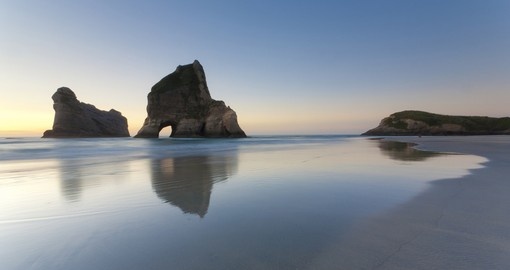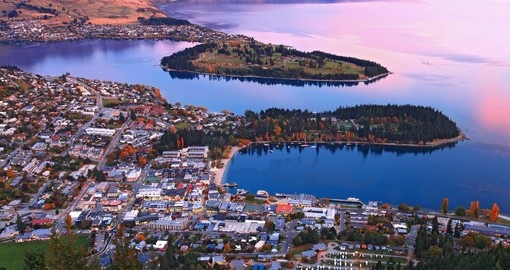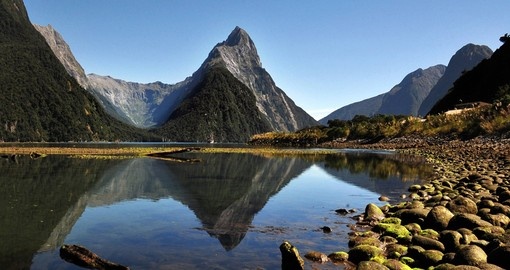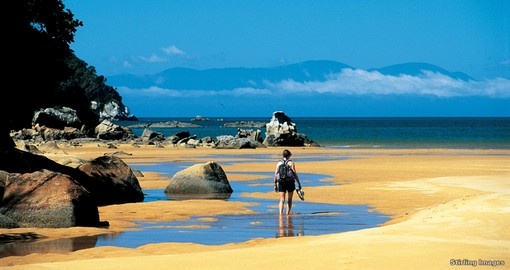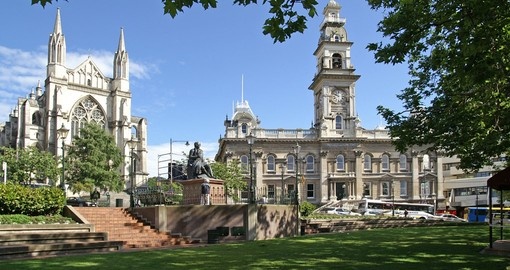New Zealand South Island Top Spots to Visit
This page details some of the top regions to explore on New Zealand's South Island, along with some independent travel ideas that can be included in your itinerary.
Visit the North Island's Top Spots page.
MARLBOROUGH
The Marlborough Sounds, made up of sheltered waterways, meanders for more than 600 miles (966 km) around secluded coves and pristine beaches, with many spots accessible only by boat. The area has unlimited opportunities for cruising, sailing, diving, and fishing. The Queen Charlotte Walkway, one of New Zealand's walking tracks contains both bush and coastal scenery. Marlborough's long, hot summers and frosty, clear winters make it ideal for grape growing and its 30 wineries produce some of the world's finest white and sparkling wines. They can be sampled on wine tours around Blenheim. Blenheim is a busy provincial town of pleasant parks and gardens, which enjoys more sunshine than anywhere else in the country.
KAIKOURA
Kaikoura, 2 hours south of Blenheim was once famous for its rock lobsters but is better known now as one of the few places in the world where it is possible to view, at close range, huge sperm whales, along with dolphins, seals, and great marine birds.
NELSON
Nelson's mild climate is ideal for horticulture. Nelson is a large fruit-growing region in New Zealand and supplies the nation's tobacco and hops. Small boutique wineries, often with cafes, flourish in the Moutere's protected, sun-drenched valleys where you will also come across local breweries and roadside produce stands. Quality studios, art and craft shops abound in the city and district.
Kahurangi National Park, a wilderness of lush rainforest and awesome limestone formations, is the site of the Heaphy and Wangapeka tracks. Nelson Lakes National Parks' high peaks and beech forests and the jewel-like lakes of Rotoiti and Rotoroa can be seen from fabulous walks and hikes. Abel Tasman National Park is primarily a coastal park. Its subtropical native forests stretch down to golden-sand beaches, estuaries, and secluded bays. Marahau Beach, at the southern end of the park, near Motueka, offers kayaking, horseback riding, boat rentals, and water taxis to various points in the park. The drive to Golden Bay, around the inland side of the Abel Tasman National Park, climbs over Takaka Hill, and the views down into Takaka Valley and out over Kahurangi National Park are incredibly spectacular. In Golden Bay, you can enjoy the uncrowded golden beaches, or visit the mesmerizing, crystal clear Waikoropupu Springs. Along Farewell Spit is a 15-mile sand spit extending into the bay, where you can take a 4WD safari to see a migratory bird sanctuary of international significance.
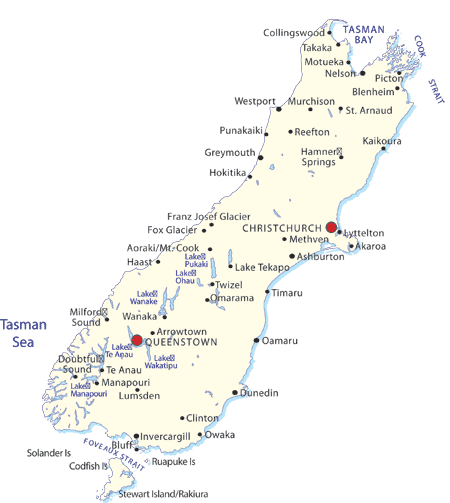
WEST COAST
The West Coast is a narrow strip of land hemmed in between the South Island's formidable Southern Alps and the Tasman Sea. With most of its natural environment still intact and preserved in six national parks and a World Heritage Site, the Coast is an unspoiled, scenic gem. This wild, sparsely populated region of mountains and glaciers, tranquil lakes, unruly rivers, lush rain forests, and a magnificent 360-mile (600 km) coastline overwhelms visitors with its grandeur and beauty.
The northern West Coast is often called Buller after its main river. The major town is Westport, a port with a coal-mining history. Nearby, Cape Foulwind is the site of the country's most accessible fur seal colony. To the north is Karamea, with its unusual limestone topography, an area of caves, sinkholes, and disappearing rivers. Here the towering Oparara Arch is the result of thousands of years of erosion by the Oparara River.
Between Westport and Greymouth, the coastline features the unique Punakaiki Pancake Rocks and blowholes. In south Westland, Whataroa, near Okariko, is the site of the only breeding station in New Zealand for the majestic white heron, a bird revered by the Maori. South Westland also has some of the most dramatic views in New Zealand the soaring Southern Alps, forest-fringed lakes, lush rain forests, and the spectacular Franz Josef and Fox Glaciers.
CANTERBURY
Canterbury, a flat, broad plain, borders the Southern Alps. Christchurch nestled in the heart of Canterbury is the South Island's largest city with a population of over 330,000. Christchurch is New Zealand's "Garden City ' full of many beautiful parks and reserves. Punting along the Avon River, through the inner city is a popular way to view the distinctively English character of the city.
North of Christchurch, Hanmer Springs is a serene, alpine thermal resort in a natural wonderland, where you can relax in the hot, mineral waters or walk the trails through plantation forests planted early in the century. Other activities include bungee jumping, mountain biking, jet boating, rafting, horseback riding, golf, and skiing.
Just over the hills from Christchurch, nestled in one of the many harbors that indent Banks Peninsula, is the bustling port of Lyttelton, where Canterbury's first settlers landed. Also on the Banks Peninsula, Akaroa, once a French settlement, still has French street signs and a charming Gaelic ambiance, along with quaint cottages, an excellent folk museum, French restaurants, and a marvelous cheese factory.
Mount Hutt, 56 miles/90 km southwest of Christchurch, is one of the most popular ski fields in New Zealand.
International competitions are staged here each year. The ski season at Mount Hutt is May to October. At the base of Mt Hutt lies the small country town of Methven, which in winter becomes a lively resort for one of New Zealand's top ski fields.
The alpine village of Arthur's Pass is a two-hour drive from Christchurch. Nestled in the foothills of the Southern Alps, it is surrounded by the spectacular Arthur's Pass National Park, popular for climbing, hiking, short walks, hunting, and fishing. A great way to see this area is by taking the TranzAlpine.
THE MACKENZIE COUNTRY AND MOUNT COOK
The road from Christchurch to Mount Cook passes through a land of lakes, vast open spaces, and golden, tussock-covered hills that roll toward the Southern Alps. On the way, you pass by the milky-blue, glacial lakes of Pukaki and Tekapo. Located on the shores of Lake Tekapo, the lonely little stone Church of the Good Shepherd has a spectacular view of Mount Cook, framed by the altar window. Mount Cook (12,349 ft), towers above the massive, snow-clad peaks that make up the Mount Cook National Park. On one side of Mount Cook is the mighty Tasman Glacier, a 19-mile giant and one of the longest outside of the Himalayas. Spectacular ski plane flights open up this majestic world to everyone. All sorts of ski options are available, including heli-skiing and ski touring. Glorious mountain walks and climbing expeditions are geared to suit every degree of fitness, and guides are available. A range of accommodations includes a hotel, chalets, a youth hostel, and a campground.
QUEENSTOWN
Queenstown lies beside Lake Wakatipu at the foot of The Remarkables mountain range. It is the South Island's most popular resort and the base for excursions into the surrounding mountains and nearby fiords, including Milford Sound. In winter, Queenstown is New Zealand's main skiing center, and in summer even larger numbers of visitors come to take part in outdoor activities ranging from trout fishing to paragliding, and white-water rafting to bungee jumping. The town is compact enough to get around on foot, with courtesy vehicles, buses, or taxis available to take you to outlying attractions. Queenstown has more than 100 restaurants, plenty of entertainment, accommodations to suit all tastes, and great shopping.
WANAKA
Wanaka, surrounded by majestic mountains lies on the shores of the glacial formed Lake Wanaka. The township is in some respects a quieter, more relaxed version of Queenstown, with a range of accommodation, from a top-class resort to motor lodges and camp grounds. The town also has a superb selection of restaurants and cafes. Rising beyond the lake, magnificent Mount Aspiring, the focal point of Mount Aspiring National Park is a favourite with hikers. Wanaka township sits at the base of the Treble Cone ski area, a favourite with snowboarders. Cardrona ski area is situated on the Crown Range between Wanaka and Queenstown and is an ideal ski field for families.
FIORDLAND
Covering nearly three million acres, wet, wild, rugged, and remote, Fiordland is one of the largest national parks in the world. A World Heritage Site, this is nature on a grand scale. Protected by its isolation, some of New Zealand's rarest birds are found here, as well as some of the country's best-known hiking tracks.
Te Anau, an attractive resort on the shores of Lake Te Anau, is the starting point for the Fiordland National Park and its many outdoor activities. Sometimes referred to as the "walking capital of the world" Te Anau acquired this reputation from the Milford, Kepler, Routeburn, Greenstone, Hollyford, and Dusky Tracks. Its accommodations range from four-star hotels and motels to backpacker hostels, campgrounds, and farmstays. It also has fine restaurants serving the specialties of the region: lobster, venison, and fresh fish.
Milford Sound is the most accessible and best known of the glacier-cut fiords. Lined with mountain peaks that rise sharply to heights of 7,000 feet, the most famous of which is Mitre Peak. Lush rainforest and majestic waterfalls abound. Wildlife includes the Fiordland Crested Penguin, fur seals, and dolphins.
OTAGO
The South Island's second-largest city and the commercial center of Otago is Dunedin, a gracious, distinctive city of grand 19th-century buildings and beautiful gardens. Dunedin is a city of culture and learning, distinguished by libraries, museums, parks, churches, and New Zealand's first university. Bearing the Gaelic form of the name Edinburgh, Dunedin was settled by Scots and made prosperous by the Otago gold rushes of the 1860s. Dunedin's Victorian character is preserved in its many fine stone buildings.
The Otago Peninsula, only 15 minutes from downtown, has an abundance of wildlife, from seabirds, fur seals, and the rare and endangered yellow-eyed penguin (hoiho). At the end of the peninsula on Taiaroa Head, the mighty albatross glides effortlessly on the updrafts. Nowhere else in the world does this, the largest of the world's seabirds, breed within such easy viewing access.
In Northern Otago, the town of Oamaru was also built from the wealth that came out of the Otago goldfields. In addition to its grand, stone Victorian buildings and fine gardens, it is noted for the two species of penguins that inhabit its shores. Farther up the coast a unique geological phenomenon, the Moeraki Boulders look as if giants have scattered enormous toy balls on the beach.
Central Otago was used during the gold rush days of the 1860s by thousands of miners. Along the Goldfields' Heritage Highway, the road runs through the quaint villages of Clyde, Lawrence, St. Bathans, and Naseby. Alexandra is the main town on the mighty Clutha River. Clyde and Cromwell are also ideal to explore.
SOUTHLAND
Southland is a region of lush green farmlands, rain forests, spectacular coastal scenery, small towns, and the longest daylight hours in the country. Its rivers and streams and lakes are filled with sizable trout, and fishing here is a way of life. The largest urban center, Invercargill is New Zealand's southernmost city. East of Invercargill on the Southern Scenic Highway from Dunedin, the Catlins Forest Park offers some great walks and magnificent coastal scenery.
Unspoiled in its isolation, Stewart Island is like stepping back in time. Reached by catamaran, airplane, or ferry across Foveaux Strait, this is the ultimate spot for anyone seeking peace and tranquillity. Here too are superb bush walks and great launch cruises in some of the most beautiful of New Zealand's coastal scenery. Bird watchers will find the island richly rewarding, and you might even spot a kiwi in its natural environment. Activities include saltwater fishing, sea kayaking, and hiking on trails provided with huts. There is comfortable accommodation at Halfmoon Bay.
New Zealand Travel Information
At Goway we believe that a well-informed traveller is a safer traveller. With this in mind, we have compiled an easy-to-navigate travel information section dedicated to New Zealand.
Learn about the history and culture of New Zealand, the must-try food and drink, and what to pack in your suitcase. Read about New Zealand's nature and wildlife, weather, and geography, along with 'Country Quickfacts' compiled by our travel experts. Our globetrotting tips, as well as our visa and health information will help ensure you're properly prepared for a safe and enjoyable trip. The only way you could possibly learn more is by embarking on your journey and discovering New Zealand for yourself. Start exploring...book one of our New Zealand tours today!
Extend Your Stay
Consider an additional stopover to your New Zealand vacation at one of Goway's South Pacific destinations. You can choose from our selection of Australian vacations, Tahiti vacation packages or stay at one of our Fiji resorts or perhaps take a Cook Island vacation. This can be done by stopping over en route to or from New Zealand.
Book your New Zealand tour with Goway!
 With more than 150 New Zealand tours and experiences, Goway’s Downunder wizards can offer you many ways to explore and enjoy New Zealand. Choose from a simple city stopover, see the country highlights on one of our classic itineraries, a self-drive holiday, a Holiday of a Lifetime, and more. We want to be your first choice when next you go globetrotting to New Zealand.
With more than 150 New Zealand tours and experiences, Goway’s Downunder wizards can offer you many ways to explore and enjoy New Zealand. Choose from a simple city stopover, see the country highlights on one of our classic itineraries, a self-drive holiday, a Holiday of a Lifetime, and more. We want to be your first choice when next you go globetrotting to New Zealand.
Get a Trip Quote Order a Brochure







